| Tech Article Title | Author | Date |
| Turning Water into Horsepower | Jeff Jones | 2006 |
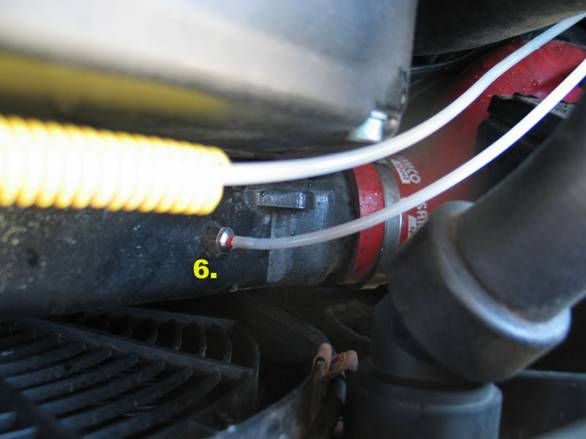
Two other components complete the system. There is a blockage indicator that illuminates when the pump fails to operate or the high-speed valve does not open. There is also a water flow meter that registers the volume of water passing through the system and displays the amount through a series of LED’s. Both the blockage indicator and water flow display are inside the cabin where the driver can monitor them.
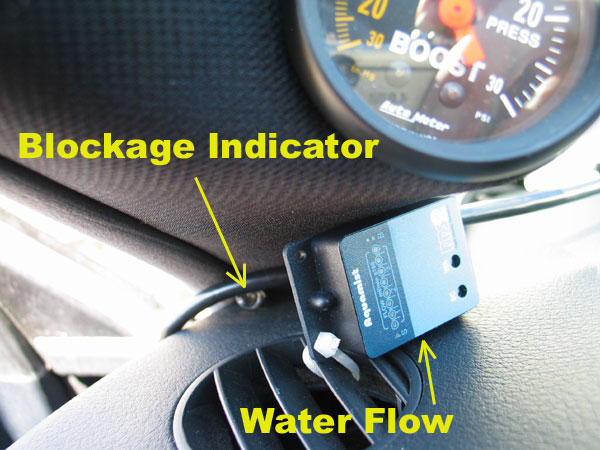
Reduced Intake Air Temperature
The most immediate benefit from water injection is the lowering of intake air temperatures. This can be realized even with a simple setup. The chart below shows how the intake air temperature on my S4 was affected with the addition of water injection.
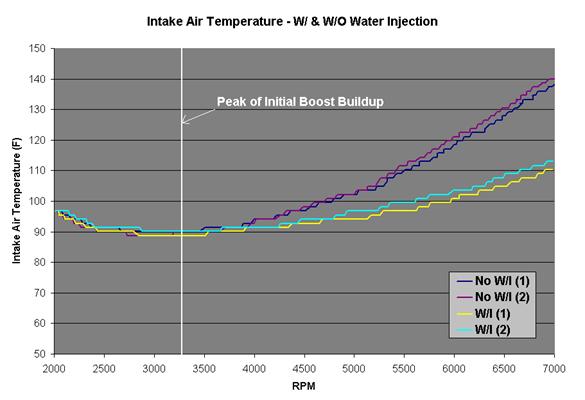
Once the car begins producing boost, an action that also raises the temperature of the air being compressed, almost immediately the water injection begins to minimize the temperature rise of the intake air beyond what the intercoolers can do alone.
The benefit is most apparent when a series of high boost pulls are made. A situation that will commonly lead to heat soak for a turbocharged car with intercoolers is no problem for an engine with water-injection.
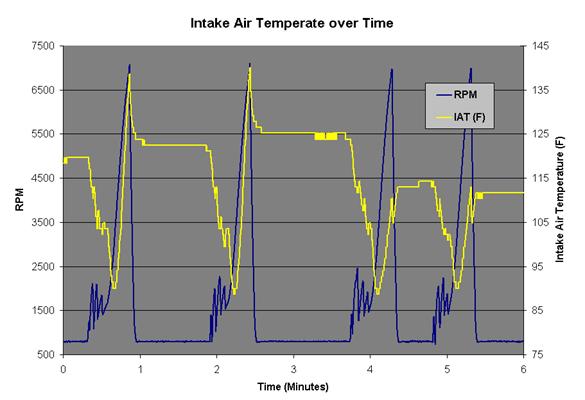
The chart above shows a series of four dynamometer pulls made with minimal cool down between pulls. The first two pulls are made with water injection off. Then the water injection is enabled for the second two pulls. In each instance the intercoolers drop the starting intake air temperature to roughly the same temperature, about 90 degrees Fahrenheit. By the end of each of the first two runs the intake air temperature has risen 50 degrees, to 140 Fahrenheit. Once water injection is activated the temperature rise is greatly reduced, increasing only 20 degrees, and ending at 110 Fahrenheit.
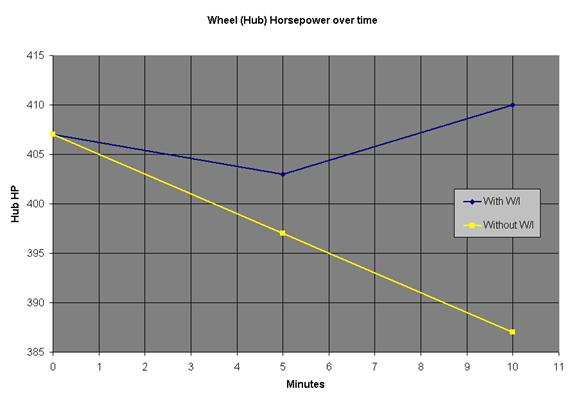 By keeping temperature rise in check the engine is able to produce the same power level over time. The graph above shows the steady decline over time in horsepower produced on my car without the benefit of water injection, and the consistent production of power when water injection is active. Note, the numbers above were produced on a Dynapack dynamometer; therefore it is not wheel horsepower, but hub horsepower.
By keeping temperature rise in check the engine is able to produce the same power level over time. The graph above shows the steady decline over time in horsepower produced on my car without the benefit of water injection, and the consistent production of power when water injection is active. Note, the numbers above were produced on a Dynapack dynamometer; therefore it is not wheel horsepower, but hub horsepower.
Making more power
Most engine management systems are designed to run correctly without water injection. If the engine is operating well, water injection may help to maintain power by cooling the intake air, but with no other changes it is unlikely to increase the power produced.
In order to realize performance gains from water injection, it is necessary to have the engine management software in the car tuned to take advantage of the water injection. For this I turned to Audi Performance and Racing, the Alabama engineering firm whose business is improving the performance of Audi automobiles. With a history of tuning the Audi engine, APR had the experience and expertise to tune my car correctly.
Even with APR on my side for the tuning, I had work to do to set my car up properly. There are many things to consider when implementing a water injection system. Each system has to be tuned specifically to the car and hardware in use. It is for this reason that a generic tune, one that is applicable to multiple cars, doesn’t exist for water injection.
The first consideration was how much water to use. A common starting point is 10 to 15 percent of the maximum fuel flow capacity of the car’s fuel injectors. My APR Stage III kit utilizes the RS4’s fuel injectors, so I chose water injection nozzles that were capable of flowing approximately fifteen percent of the maximum capacity of all six RS4 injectors combined.
The other decision concerned the mixture being injected. Water injection does not require that just water be injected; a percentage of the total mixture consisting of some methyl alcohol (methanol) can also be used. 100% water has the greatest cooling capacity, but because I was planning to use the windshield washer reservoir to supply the system I still wanted to be able to clean off my windshield and keep the fluid from freezing in cold weather. Methyl alcohol is a common additive to windshield washer fluid, and happens to increase the effective octane level of the mixture very slightly as well as evaporating easily. It cannot absorb as much heat energy as water, or release as much energy as gasoline when it burns, but the right mixture would be a good compromise between functionality and performance for my situation. I decided on a mixture of approximately 80% water to 20% methanol.
The Tune
With all the pieces in place it was time for APR to do their stuff. First they evaluated the condition of my car to be sure that there weren’t any problems with its operation. Next they performed some baseline dynamometer runs to determine the power levels the car was making as well as giving them the chance to collect engine operating data. Once they had a clear picture of what they were working with they began to tweak their 93-octane engine code, the gasoline I use most often, to operate in conjunction with the water injection system.
The first step was to adjust the trigger point at which the system would be activated. With knock most likely to occur around the peak engine load, this led to setting the threshold at 5 psi of boost pressure.
The first change to the software involved leaning the fuel mixture. The mixture was leaned out to the point that the exhaust gas temperatures began to rise, and then backed off slightly to a richer mixture. Boost was next increased slightly in the upper rpm range. Finally, the timing advance was looked at, but the decision was made to leave it alone because the ignition retard values had stayed consistent throughout the previous steps.
The Results
When all was said and done, and APR was finished with their work, the car went back to the dynamometer. The chart below shows back-to-back tests comparing the standard 93-octane software to the water injection software. The base case is the standard 93-octane program and the test case is the 93-octane water injection program. An impressive 22-wheel horsepower, or roughly 30 more crank horsepower, were produced with water injection activated.
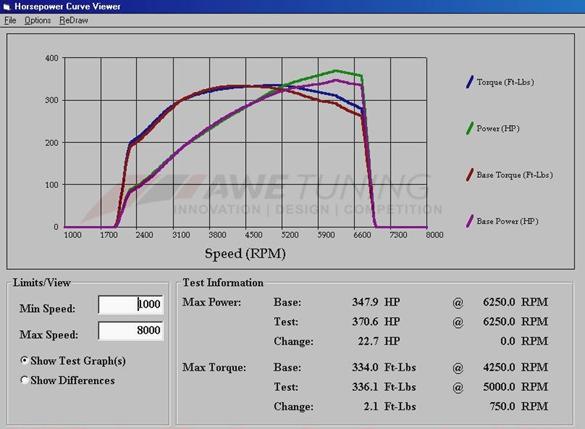
So how would this compare to using race gas? Well besides the fact that water is much cheaper than 100-octane fuel, water injection cuts in half the performance gap between 93-octane and 100-octane in my car. My S4 produces about 47 wheel horsepower more on 100-octane fuel than it does on 93-octane. Water injection tuning provides a 22 wheel horsepower improvement over regular 93-octane tuning.
Water Injection Drawbacks
Despite the benefits that water injection offers, there are some valid reasons why water injection isn’t being used in every car on the road. It requires the installation of extra equipment that complicates the vehicle and requires some upkeep, like occasionally cleaning the nozzles and inline filter. Also, safeguards need to be installed to ensure that water is always flowing when needed, that the operator is alerted to a low water condition and to remove heavy loads from the engine if the water flow stops. For if the water flow were to stop while the car was under a heavy load, the engine could be damaged.
Conclusions
When it comes to water injection, the increase in performance realized from the tune depends upon what you and your tuner are comfortable with. APR and I both wanted to finesse some more performance from my S4, but we were in agreement that it needed to be done safely. Water injection, when taken to the extreme, allows you to run high boost, advanced ignition timing, and lean air-to-fuel ratios, all conditions which can quickly lead to a ruined engine if not managed carefully. On the other hand, water injection could act more as a safety buffer to a car that is otherwise well tuned.
APR and I did what should be considered a first round of development. We uncovered some significant gains, but we were time limited to testing with a single nozzle size and only the 80/20 water-methanol mixture. In the next stage of development we hope to find out what affect other mixtures have, looking at 100% water all the way to a 50/50 water-methanol mixture. We would also like to test and observe what affect other size nozzles have on this engines performance potential.
In the end, when it comes to water injection tuning, where you choose to stop depends upon your comfort level. As APR has demonstrated, even with a conservative tune, when the tuning is done properly, water injection has great potential for upping the already impressive performance figures of the Audi S4 Stage III
Rothrock, A.M., Krsek, A. Jr., Jones, A.W., “The induction of water to the inlet air as a means of internal cooling aircraft-engine cylinders,” NACA Report 756 (1943): 1.